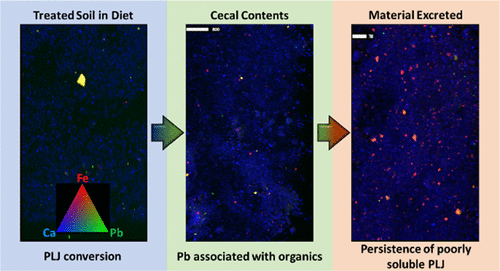当前位置:
X-MOL 学术
›
Environ. Sci. Technol.
›
论文详情
Our official English website, www.x-mol.net, welcomes your
feedback! (Note: you will need to create a separate account there.)
Plumbojarosite Remediation of Soil Affects Lead Speciation and Elemental Interactions in Soil and in Mice Tissues
Environmental Science & Technology ( IF 10.8 ) Pub Date : 2021-11-22 , DOI: 10.1021/acs.est.1c06067 Tyler D Sowers 1 , Sharon E Bone 2 , Matthew R Noerpel 3 , Matthew D Blackmon 1 , Ranju R Karna 4 , Kirk G Scheckel 3 , Albert L Juhasz 5 , Gary L Diamond 6 , David J Thomas 7 , Karen D Bradham 1
Environmental Science & Technology ( IF 10.8 ) Pub Date : 2021-11-22 , DOI: 10.1021/acs.est.1c06067 Tyler D Sowers 1 , Sharon E Bone 2 , Matthew R Noerpel 3 , Matthew D Blackmon 1 , Ranju R Karna 4 , Kirk G Scheckel 3 , Albert L Juhasz 5 , Gary L Diamond 6 , David J Thomas 7 , Karen D Bradham 1
Affiliation

|
Lead (Pb) contamination of soils is of global concern due to the devastating impacts of Pb exposure in children. Because early-life exposure to Pb has long-lasting health effects, reducing exposure in children is a critical public health goal that has intensified research on the conversion of soil Pb to low bioavailability phases. Recently, plumbojarosite (PLJ) conversion of highly available soil Pb was found to decrease Pb relative bioavailability (RBA <10%). However, there is sparse information concerning interactions between Pb and other elements when contaminated soil, pre- and post-remediation, is ingested and moves through the gastrointestinal tract (GIT). Addressing this may inform drivers of effective chemical remediation strategies. Here, we utilize bulk and micro-focused Pb X-ray absorption spectroscopy to probe elemental interactions and Pb speciation in mouse diet, cecum, and feces samples following ingestion of contaminated soils pre- and post-PLJ treatment. RBA of treated soils was less than 1% with PLJ phases transiting the GIT with little absorption. In contrast, Pb associated with organics was predominantly found in the cecum. These results are consistent with transit of insoluble PLJ to feces following ingestion. The expanded understanding of Pb interactions during GIT transit complements our knowledge of elemental interactions with Pb that occur at higher levels of biological organization.
中文翻译:

土壤的铅黄钾铁矾修复影响土壤和小鼠组织中的铅形态和元素相互作用
由于儿童接触铅的破坏性影响,土壤中的铅 (Pb) 污染已引起全球关注。由于早期接触铅具有长期的健康影响,因此减少儿童接触是一项重要的公共卫生目标,加强了对土壤铅转化为低生物利用度阶段的研究。最近,发现高有效土壤 Pb 的铅黄钾铁矾 (PLJ) 转化会降低 Pb 的相对生物有效性(RBA <10%)。然而,当被污染的土壤、修复前后、被摄入并通过胃肠道 (GIT) 移动时,关于 Pb 与其他元素之间相互作用的信息很少。解决这个问题可能会为有效化学修复策略的驱动因素提供信息。这里,我们利用散装和微聚焦 Pb X 射线吸收光谱来探测 PLJ 处理前后摄入受污染土壤后小鼠饮食、盲肠和粪便样品中的元素相互作用和 Pb 形态。处理过的土壤的 RBA 低于 1%,PLJ 相通过 GIT 几乎没有吸收。相比之下,与有机物相关的铅主要存在于盲肠中。这些结果与摄入后不溶性 PLJ 向粪便的转运一致。对 GIT 运输过程中 Pb 相互作用的扩展理解补充了我们对在更高水平的生物组织中发生的元素与 Pb 相互作用的知识。处理过的土壤的 RBA 低于 1%,PLJ 相通过 GIT 几乎没有吸收。相比之下,与有机物相关的铅主要存在于盲肠中。这些结果与摄入后不溶性 PLJ 向粪便的转运一致。对 GIT 运输过程中 Pb 相互作用的扩展理解补充了我们对在更高水平的生物组织中发生的元素与 Pb 相互作用的知识。处理过的土壤的 RBA 低于 1%,PLJ 相通过 GIT 几乎没有吸收。相比之下,与有机物相关的铅主要存在于盲肠中。这些结果与摄入后不溶性 PLJ 向粪便的转运一致。对 GIT 运输过程中 Pb 相互作用的扩展理解补充了我们对在更高水平的生物组织中发生的元素与 Pb 相互作用的知识。
更新日期:2021-12-07
中文翻译:

土壤的铅黄钾铁矾修复影响土壤和小鼠组织中的铅形态和元素相互作用
由于儿童接触铅的破坏性影响,土壤中的铅 (Pb) 污染已引起全球关注。由于早期接触铅具有长期的健康影响,因此减少儿童接触是一项重要的公共卫生目标,加强了对土壤铅转化为低生物利用度阶段的研究。最近,发现高有效土壤 Pb 的铅黄钾铁矾 (PLJ) 转化会降低 Pb 的相对生物有效性(RBA <10%)。然而,当被污染的土壤、修复前后、被摄入并通过胃肠道 (GIT) 移动时,关于 Pb 与其他元素之间相互作用的信息很少。解决这个问题可能会为有效化学修复策略的驱动因素提供信息。这里,我们利用散装和微聚焦 Pb X 射线吸收光谱来探测 PLJ 处理前后摄入受污染土壤后小鼠饮食、盲肠和粪便样品中的元素相互作用和 Pb 形态。处理过的土壤的 RBA 低于 1%,PLJ 相通过 GIT 几乎没有吸收。相比之下,与有机物相关的铅主要存在于盲肠中。这些结果与摄入后不溶性 PLJ 向粪便的转运一致。对 GIT 运输过程中 Pb 相互作用的扩展理解补充了我们对在更高水平的生物组织中发生的元素与 Pb 相互作用的知识。处理过的土壤的 RBA 低于 1%,PLJ 相通过 GIT 几乎没有吸收。相比之下,与有机物相关的铅主要存在于盲肠中。这些结果与摄入后不溶性 PLJ 向粪便的转运一致。对 GIT 运输过程中 Pb 相互作用的扩展理解补充了我们对在更高水平的生物组织中发生的元素与 Pb 相互作用的知识。处理过的土壤的 RBA 低于 1%,PLJ 相通过 GIT 几乎没有吸收。相比之下,与有机物相关的铅主要存在于盲肠中。这些结果与摄入后不溶性 PLJ 向粪便的转运一致。对 GIT 运输过程中 Pb 相互作用的扩展理解补充了我们对在更高水平的生物组织中发生的元素与 Pb 相互作用的知识。











































 京公网安备 11010802027423号
京公网安备 11010802027423号